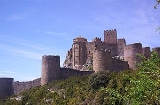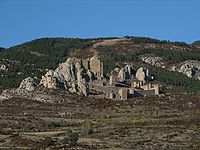
Loarre castle
Encyclopedia
Loarre Castle is a fortress in Loarre
, Spain. The complex was built largely during the 11th and 12th centuries, when its position on the frontier between Christian
and Muslim
lands gave it strategic importance. The first of the two major building programs began ca. 1020, when Sancho el Mayor (r. 1063–94) reconquered the surrounding lands from the Muslims. At least three towers, two of which survive, the Homage tower (Torre del Homenaje) and the "Tower of the Queen" (Torre de la Reina), as well as a chapel dedicated to Saint Mary of Valverde and connecting walls are attributed to this campaign. The Homage tower was built in an isolated position in front of the fortifications, to which it was connected by a wooden bridge. It contained a basement and five floors. The Torre de la Reina, comprising a basement and three floors, is particularly noteworthy for three sets of twin-arched windows, with columns of exaggerated entasis
and trapezoidal capitals
that have been related to both Lombard
and Mozarab
ic architectural forms. The chapel is composed of a single-cell nave with an eastern apse covered by a semicircular vault. The original timber roof of the nave was replaced by a vault at the end of the 11th century.
 After 1070, Loarre became increasingly important. In 1073, King Sancho installed a community of Augustinian canons, and it was from Loarre that he prepared for the conquest of Huesca
After 1070, Loarre became increasingly important. In 1073, King Sancho installed a community of Augustinian canons, and it was from Loarre that he prepared for the conquest of Huesca
in 1094. In 1097, however, his successor, Peter I of Aragon and Navarre
, donated all the goods of Loarre to a new royal monastery at Montearagon
. This evidence suggests that the second major construction program was undertaken between 1073 and 1097, and much building evidently does date from this period. By comparison with other monuments, however, it is also clear that the building and decorative program continued into the 12th century.
just outside the castle walls.
The outermost walls of the castle and their eight towers were erected in the 13th or 14th century. The church and castle have been the subject of numerous restorations, a major one in 1913 and subsequent ones, particularly during the 1970s, have resulted in the rebuilding of many walls and towers that had fallen into disrepair.
Loarre
Loarre is a municipality in the province of Huesca, Spain. As of 2010, it has a population of 371 inhabitants.- External links :...
, Spain. The complex was built largely during the 11th and 12th centuries, when its position on the frontier between Christian
Christian
A Christian is a person who adheres to Christianity, an Abrahamic, monotheistic religion based on the life and teachings of Jesus of Nazareth as recorded in the Canonical gospels and the letters of the New Testament...
and Muslim
Muslim
A Muslim, also spelled Moslem, is an adherent of Islam, a monotheistic, Abrahamic religion based on the Quran, which Muslims consider the verbatim word of God as revealed to prophet Muhammad. "Muslim" is the Arabic term for "submitter" .Muslims believe that God is one and incomparable...
lands gave it strategic importance. The first of the two major building programs began ca. 1020, when Sancho el Mayor (r. 1063–94) reconquered the surrounding lands from the Muslims. At least three towers, two of which survive, the Homage tower (Torre del Homenaje) and the "Tower of the Queen" (Torre de la Reina), as well as a chapel dedicated to Saint Mary of Valverde and connecting walls are attributed to this campaign. The Homage tower was built in an isolated position in front of the fortifications, to which it was connected by a wooden bridge. It contained a basement and five floors. The Torre de la Reina, comprising a basement and three floors, is particularly noteworthy for three sets of twin-arched windows, with columns of exaggerated entasis
Entasis
In architecture, entasis is the application of a convex curve to a surface for aesthetic purposes. Its best-known use is in certain orders of Classical columns that curve slightly as their diameter is decreased from the bottom upwards. In the Hellenistic period some columns with entasis are...
and trapezoidal capitals
Capital (architecture)
In architecture the capital forms the topmost member of a column . It mediates between the column and the load thrusting down upon it, broadening the area of the column's supporting surface...
that have been related to both Lombard
First Romanesque
First Romanesque is the name due to Josep Puig i Cadafalch to refer to the Romanesque art developed in Catalonia since the late 10th century....
and Mozarab
Mozarab
The Mozarabs were Iberian Christians who lived under Arab Islamic rule in Al-Andalus. Their descendants remained unconverted to Islam, but did however adopt elements of Arabic language and culture...
ic architectural forms. The chapel is composed of a single-cell nave with an eastern apse covered by a semicircular vault. The original timber roof of the nave was replaced by a vault at the end of the 11th century.

Huesca
Huesca is a city in north-eastern Spain, within the autonomous community of Aragon. It is also the capital of the Spanish province of the same name and the comarca of Hoya de Huesca....
in 1094. In 1097, however, his successor, Peter I of Aragon and Navarre
Peter I of Aragon and Navarre
Peter I was the King of Aragon and Navarre for a decade from 1094 until his death. He was the son and successor of Sancho V Ramírez by his first wife, Isabella of Urgell. He was named in honour of Saint Peter, because of his father's special devotion to the Holy See, to which he had made his...
, donated all the goods of Loarre to a new royal monastery at Montearagon
Montearagón, Toledo
Montearagón is a municipality located in the province of Toledo, Castile-La Mancha, Spain. According to the 2006 census , the municipality has a population of 549 inhabitants....
. This evidence suggests that the second major construction program was undertaken between 1073 and 1097, and much building evidently does date from this period. By comparison with other monuments, however, it is also clear that the building and decorative program continued into the 12th century.
Layout
The castle's location on a rocky outcrop affected the layout; it was not possible to have one unified structure, and like many castles Loarre was a collection of buildings bounded by curtain walls. Originally the internal plan included two towers and a chapel behind several curtain walls. Towards the end of the 11th century an additional chapel was built in Romanesque styleRomanesque architecture
Romanesque architecture is an architectural style of Medieval Europe characterised by semi-circular arches. There is no consensus for the beginning date of the Romanesque architecture, with proposals ranging from the 6th to the 10th century. It developed in the 12th century into the Gothic style,...
just outside the castle walls.
The outermost walls of the castle and their eight towers were erected in the 13th or 14th century. The church and castle have been the subject of numerous restorations, a major one in 1913 and subsequent ones, particularly during the 1970s, have resulted in the rebuilding of many walls and towers that had fallen into disrepair.

